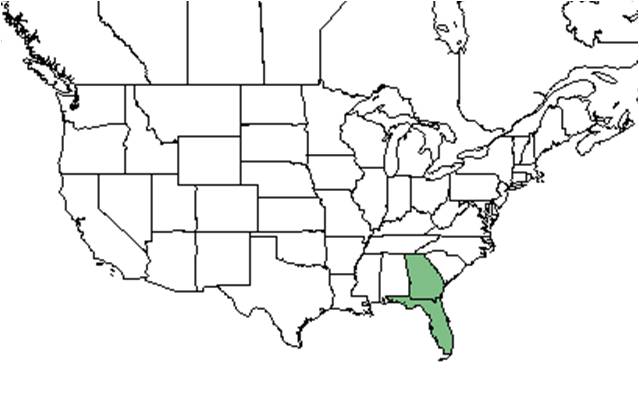Sisyrinchium xerophyllum
| Sisyrinchium xerophyllum | |
|---|---|

| |
| Photo by Shirley Denton (Copyrighted, use by photographer’s permission only), Nature Photography by Shirley Denton | |
| Scientific classification | |
| Kingdom: | Plantae |
| Division: | Magnoliophyta - Flowering plants |
| Class: | Liliopsida – Monocotyledons |
| Order: | Liliales |
| Family: | Iridaceae |
| Genus: | Sisyrinchium |
| Species: | S. xerophyllum |
| Binomial name | |
| Sisyrinchium xerophyllum Greene | |

| |
| Natural range of Sisyrinchium xerophyllum from USDA NRCS Plants Database. | |
Common names: Jeweled blue-eyed grass, Florida Blue-eyed grass
Contents
Taxonomic notes
The specific epithet xerophyllum refers to the habitat this species grows in: well-drained sandy uplands.[1]
Description
A description of Sisyrinchium xerophyllum is provided in The Flora of North America.
Distribution
This species is endemic to Florida and southern Georgia.[1]
Ecology
Habitat
In the Coastal Plain in Florida, S. xerophyllum occurs surrounding limestone glades with wiregrass, open barrens, scrub oak-wiregrass sand ridges, pine-turkey oak flats, and interdune swales. It has also can be found in disturbed areas such as sandy parking lots and roadsides. Soils include sandy loam, loamy sand, sand, and loam. It grows in shaded environments. Associated species include Carex fissa, C. vexans, Chrysopsis linearifolia, Andropogon virginicus, Aristida stricta, Pteridium aquilinum var. subcaudatum, Smilax auriculata and Panicum virgatum.[2]
Phenology
Flowers have six blue tepals, yellow bases and usually aristae tips. Flowers March through November and fruits May through November.[2]
Seed dispersal
According to Kay Kirkman, a plant ecologist, this species disperses by gravity. [3]
Fire ecology
S. xerophyllum has been observed to be a weak resprouter after fire. It decreases in frequency and abundance post fire.[4]
Pollination
The following Hymenoptera families and species were observed visiting flowers of Sisyrinchium xerophyllum at Archbold Biological Station: [5]
Halictidae: Lasioglossum nymphalis, L. placidensis
Megachilidae: Anthidiellum perplexum, Megachile brevis pseudobrevis
Conservation and management
Cultivation and restoration
Photo Gallery
References and notes
- ↑ 1.0 1.1 [[1]]Native Florida Wildflowers. Accessed: March 16, 2016
- ↑ 2.0 2.1 Florida State University Robert K. Godfrey Herbarium database. URL: http://herbarium.bio.fsu.edu. Last accessed: November 2015. Collectors: Loran C. Anderson, Billy Bailey, Wilson Baker, J. Beckner, Robert K. Godfrey, Beverly Judd, Walter S. Judd, Ed Keppner, Lisa Keppner, Robert Kral, O. Lakela, Hugh O’Neill, Daniel B. Ward. States and Counties: Florida: Bay, Franklin, Highlands, Jackson, Leon, Marion, Marin, Polk, Wakulla, Walton. Compiled by Tall Timbers Research Station and Land Conservancy.
- ↑ Kay Kirkman, unpublished data, 2015.
- ↑ Weekley, C. W. and E. S. Menges (2003). "Species and vegetation responses to prescribed fire in a long-unburned, endemic-rich Lake Wales Ridge scrub." Journal of the Torrey Botanical Club 130: 265-282.
- ↑ Deyrup, M.A. and N.D. 2015. Database of observations of Hymenoptera visitations to flowers of plants on Archbold Biological Station, Florida, USA.